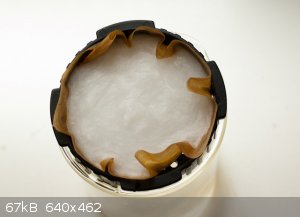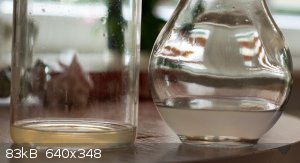hexahydrate
Harmless

Posts: 15
Registered: 17-3-2018
Member Is Offline
Mood: No Mood
|
|
My sodium peroxide 8-hydrate synthesis
I found an old thread https://www.sciencemadness.org/talk/viewthread.php?tid=10 and decided to try it myself, as this synthesis doesn't require any advanced glassware.
Just right for the current state of my lab.
I used fresh, lab grade sodium hydroxide and "active oxygen" for pool cleaning, which is 20% hydrogen peroxide. Seems to be pure H2O2 solution, no
strange additives  . .
First, ~17 ml of 20% H2O2 was measured in a graduated cylinder.
Then, 25 ml of cold water (~8C) was added to a beaker and 10g NaOH was dissolved. Solution got very hot so it was put into the fridge to cool again.
Then, it was transferred to a flask (lightbulb shape, made from thick glass. Found them in local supermarket for 0,6€ and immediately thought, they
will make great erlenmayer replacement for simple reactions).
H2O2 was added with a pipette, slowly, drop by drop and with stirring (manual, as I have no magnetic stirrer). After each couple of drops added, flask
was put into ice-cold water, to keep the mixture cool. As soon, as first drops of H2O2 were added, white particles started to appear in the liquid.
With more H2O2 added, liquid turned into rather thick white slurry. Then, 60 ml of ice-cold 91% isopropanol was added. Procedure cited in the oroginal
thread calls for 95% ethanol, but I didn't have any. Nevertheless, isopropanol worked equally well, and white mass of the product separated from the
solution. It was put in the fridge for 20 minutes, then the liquid was decanted and the solid product put on a coffee filter paper. Unfortunatelly, it
remained thick white slurry. Without vaccuum filtration it seems impossible to get well dried product. A little bit of the product was mixed with
KMnO4 and bubbling occured and permanganate turned brown, so classic peroxide reaction.
I'm disapponted that it is very different than anhydrous sodium peroxide and that there is apparently no way to get anhydrous Na2O2 from the
8-hydrate. According to "Inorganic Syntheses Volume III", cited in the original post, only 2-hydrate can be obtained, by keeping 8-hydrate in a vaccum
desiccator over conc. sulfuric acid. I wonder, if P2O5 could fully dehydrate it in such conditions.
Now, is there anything interesting, I can use Na2O2*8H2O for ? Something better, than hydrolyse it back to NaOH and H2O2 ? Well, I tested it on a
cloth stained with cherry juice and as expected it cleaned the stains almost completly.
  
|
|
|
symboom
International Hazard
    
Posts: 1143
Registered: 11-11-2010
Location: Wrongplanet
Member Is Offline
Mood: Doing science while it is still legal since 2010
|
|
dry it using a brake line vacuum works well and sulfuric acid just put both in a vacuum chamber and let the sulfuric acid absorb the water in
separate containers of course
Desication is great. Awesome experiment
[Edited on 27-6-2018 by symboom]
|
|
|
Tsjerk
International Hazard
    
Posts: 3022
Registered: 20-4-2005
Location: Netherlands
Member Is Offline
Mood: Mood
|
|
I don't think you would get to the anhydrous salt with P2O5, as you would need the water to evaporate anyway with both sulfuric acid and P2O5.
|
|
|
woelen
Super Administrator
        
Posts: 7976
Registered: 20-8-2005
Location: Netherlands
Member Is Offline
Mood: interested
|
|
You will never get anhydrous Na2O2 from an aqueous solution. The ion O2(2-) is a very strong base and it is completely and irreversibly hydrolyzed in
water to HO2(-). From water you simply cannot get O2(2-) ions. This is similar to the fact that from water you never can get O(2-) ions. These ions
always will form OH(-).
Actually, the so-called Na2O2.8H2O is not a true compound of O2(2-) at all. It is a double salt of NaOOH and NaOH, with water of crystallization in
the lattice. The combination of NaOOH and NaOH is less soluble in water than plain NaOH and this causes your white precipitate. This combination of
salts being less soluble than the constituents is quite common (another well-known double-salt is alum, which is less soluble than separate K-sulfate
and Al-sulfate). Double-salts should not be confused with complexes. The ions still are present as separate entities.
You will never get anything better than NaOOH.NaOH (which usually incorrectly is written as Na2O2.H2O) and most likely even this is very hard to
obtain. Apparently, when dried over H2SO4 or P4O10, you get NaOOH.NaOH.H2O (incorrectly written as Na2O2.2H2O).
|
|
|
hexahydrate
Harmless

Posts: 15
Registered: 17-3-2018
Member Is Offline
Mood: No Mood
|
|
Thank you woelen for beautiful explanation. I believed it was true peroxide, like CaO2 or ZnO2.
|
|
|
tahallium
Harmless

Posts: 41
Registered: 24-2-2020
Location: Tunisia
Member Is Offline
|
|
But is it useful for pyrotechnics?
|
|
|
woelen
Super Administrator
        
Posts: 7976
Registered: 20-8-2005
Location: Netherlands
Member Is Offline
Mood: interested
|
|
No, but anhydrous Na2O2 also is not useful for pyrotechnics, unless you don't mind burning (or losing) your fingers or hands.
[Edited on 29-3-20 by woelen]
|
|
|
teodor
National Hazard
   
Posts: 872
Registered: 28-6-2019
Location: Heerenveen
Member Is Offline
|
|
Hm, but why is it still possible to make BaO2 by this procedure? Is there something with O2(2-) in water which works differently in a case of Ba2+?
"Thirty grams of barium hydroxide are agitated with 500 ml of distilled water in a stoppered Erlenmeyer flask at 14° C until no more of the alkali
dissolves. The mixture is then filtered by suction into 25 ml of fresh 3% hydrogen peroxide. The barium peroxide 8-hydrate that forms is first
dehydrated in vacuum over phosphorus pontoxide in a desiccator, and then at 100°C. The yield of barium peroxide is 2.5-3 g."
(see https://www.prepchem.com/synthesis-of-barium-peroxide/)
|
|
|